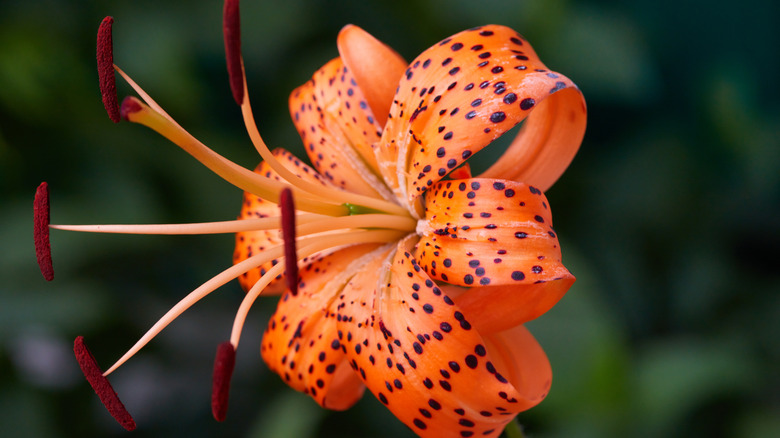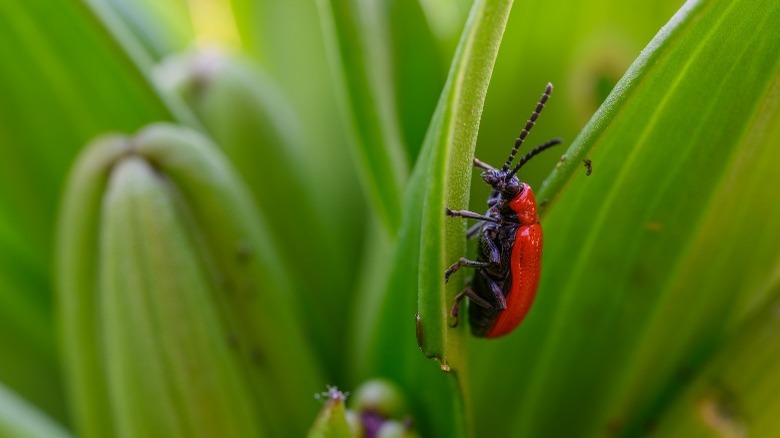Tiger Lilies: Everything You Should Know Before Planting
We've always had a special spot in our heart for lilies. Their flowery blossoms, seamless growth process, year-round independence, and ability to tolerate drought and remain aesthetically pleasing keep us hooked. That explains our recurring pieces on how to grow lilies here at House Digest. Much earlier, we discussed how to raise a Queen Emma lily, and not quite long ago, we did a piece on the popular lily of the valley. Today, we're here with one more species known as the tiger lily (Lilium Lancifolium).
The tiger lily is a herbaceous perennial with green leaves and long and strappy stems that blooms in midsummer. The flowers tend to blossom in orange with notable black spots — which we think makes it reminiscent of a leopard. This perennial is a plus for every gardener and garden, because not only is it easy to grow, but you also get bragging rights because they bloom in numbers. Tiger lilies grow best in USDA hardiness zones of about 3 through 9, writes Michigan Bulb Co., and can grow up to 3 to 5 feet tall and 7 inches wide.
How to use tiger lilies in your garden
The very first perk of having this flower in your garden is that it indiscriminately serves as a pest repellant. Imagine never having to purchase pest and disease repellents as a matter of urgency? Yup, Gardenia writes that the tiger lily helps protect other plants from pests, even more so as it multiplies in bulbs underground.
Another way to use tiger lilies in your garden is for their aesthetic appeal — we mean, what's the point of having flowers that don't add all the color and pop and beauty to your garden? Additionally, the multiplication rate of this downward-facing, spotty orange flower is fast, providing you with the crème de la crème of lily beauty, says One Green Plant.
Lastly, if you live in climes that are susceptible to drought and you want a flower that will thrive nonetheless (because, let's face it, what's the point of growing flowers only to have them die after one season?), you should grow the tiger lily, writes The Gazette.
How to grow tiger lilies
First off, we have to establish that growing a tiger lily is quite simple. Does it seem too good to be true? We'll wager that we can convince you. First off, growing tiger lilies does not start from a seed, as you might have assumed because of its antecedents. Instead, you grow them from bulbs, says American Meadows – bulbs that you either separate from other tiger lilies or purchase right from a store. We'll stick with the store story here.
Secondly, you can plant one in the fall and you'll have a bloom in late summer. Sounds great, doesn't it? Let's go right ahead and learn how. According to Pickup Flowers, the first step to growing a tiger lily is to find the perfect location, soil, and temperature zones. This affects the overall turnout of your plant. The ideal conditions as specified are spots where the plant can get up to six to eight hours of sunlight daily, rich and well-draining soil, and a USDA hardiness zone from 3 to 9 (an amazing range!). Afterward, your next step is to till the ground and then place the bulb in it with the larger part being on the bottom and the top pointy part facing upward. Support the bulb with a hand and cover it up with mulch, compost, and soil.
How to care for tiger lilies
Now that you have your tiger lily plant well-established in your garden, the next step will be to ensure it blooms and doesn't die, as well as how to maintain it even after blooming. We have a lot of information for you, so you might want to get a pen. Just kidding — this plant is very easy to take care of; lazy gardeners will easily find it a favorite.
As you know, the standards are six to eight hours of sunlight daily. However, according to the experts at Michigan Bulb Co., tiger lilies can also tolerate part shade. The only major maintenance you have to do with this plant is the water control issue. Remember that we recommended tilling the land before planting? Well, that was to ensure that you have a sufficient draining system as too much water can rot the roots of the tiger lily, and then all your work will have been for nothing.
When it comes to pruning the plant, you should bear in mind that after blooming the foliage of the tiger lily plant tends to turn yellow. Once this happens, uniformly, it's time to prune to ground level and dispose of it. Finally, on the drainage matter, it is important to add humus or compost every once in a while to help the drainage process and to, of course, prevent rot.
Tiger lily varieties
There are at least nine varieties of the tiger lily plant. However, none of them are pure cultivars, sadly. Instead, they are more of cross-bred variation with other plants, writes Plant Lilies. These variations are mostly native to Asia, whereas the original tiger lily is native to North America.
The known variations of the conventional tiger lily (Lilium lancifolium or L. Tigrinum) include, but are not limited to, Lilium tigrinum, Asiatic hybrids, Lilium catesbaei, pine lily, leopard lily (see!), Easter lily, Oregon lily, oriental hybrids, and Kenton lily.
-
Asiatic Hybrids: This variation bears a striking resemblance to the martagon. Its major colors are peach with plum freckles and a darker peach color at its crux — a strikingly beautiful lily, we might add! The experts at John Scheepers say that this one blooms in the early summer and can grow up to 4 to 8 inches wide and 3 to 5 feet tall.
-
Pine Lily: The distinguishing characteristic of the pine lily (lilium catesbaei) is its red petals mixed with a buttery yellow and then an abundance of purple spots. These lilies can grow up to 2 to 3 inches tall and are native to Florida, writes The Florida Wildflower Foundation.
-
Easter Lily: This variation of the tiger lily is more of a celebration plant. According to South Dakota State University Extension, they are available just before Easter and are grown for that purpose. They can grow up to 4 to 7 inches tall.
Are tiger lilies toxic?
Right, now the toxicity question. Each time we do a piece on a new plant, we feel obliged to tell you that it is important that you know the toxicity levels before planting it. Toxic plants can cause a serious problem for your pets, toddlers, and even you; ignorance is not an option. It might seem like we're reading you the riot act, but it's better than a sick pet — you'll agree, won't you? Great!
Eat the Weeds say that the tiger lily is an edible plant. It has been used to make stellar concoctions like traditional meals in Japan, writes Pro Garden Tips. However, just because it is edible doesn't mean it is toxin-free. Come along, we'll explain what we mean.
First off, if you're a cat mom, or dad, or granny, in general if you are a cat person it is important to note that this plant is deathly toxic to your furry kitten, says Pet Poison Helpline. So, you might want to keep the tiger lily off your garden list — unless, of course, you can manage the risks (we would not recommend this though). Next up, while it is edible to humans, some sources say that tiger lily pollen can be toxic to humans. Weird combo — we found it fishy so we decided to dig in. What we found out was that if you get exposed to the pollen, it's likely nothing will happen to you.
How to repot tiger lilies
There's one caveat, gardeners — the tiger lily is an invasive plant. Now that we've done our part to let you know, we'll teach you how to manage it. Did you think we were going to leave you hanging? Nope, we don't do that here.
Since they grow from bulbs (bulbs which replicate underneath the ground), tiger lilies tend to grow on their own. You might not have to repot them, unless you want them strategically planted — and we wager that you do want them strategically planted.
The best time to propagate tiger lilies is in spring or fall. This will ensure that you see the next summer's bloom. Now that you know, here's how to do it. Gardening Know How says that the first thing to do is to dig up the existing plant, carefully divide the bulb with your hands, and then cover up the original. Pick a location for the next plant (remember the six to eight hours of full sun measure), till the ground for proper drainage, and replant the bulb in the same way we discussed much earlier. Take good care of this new one and you'll have an exotic bloom in the next few months!
How to care for tiger lilies in the winter
So you may be asking how to take care of tiger lilies in the wintertime. Plant Care Today says we need to cut these flowers back and prune them once a year for them to last longer and keep their lush beauty. If you've never grown tiger lilies before, you might be fooled into thinking they've died when they have entered their dormant stage. This happens just before winter, so it's important to cut them back in the fall before this occurs. You may mistake that this hardy plant is dying towards the end of summer when the leaves begin to turn yellow. In reality, it's preparing for its dormant stage.
You want to allow the yellow leaves to remain but cut back the ones that die. This will give the plant the best chance for survival through the winter months and subsequently thrive the following spring. The annual pruning of your tiger lilies is also important to its overall health because it will help prevent both disease and pests. Trimming and removing the dead leaves will prevent rot that develops in the roots, and additionally helps guard against pests being attracted. Beware of over-pruning, however, and wait until they turn brown, never removing too many at once, or the plant is at risk of losing its ability to flower. According to the Farmers' Almanac, you'll also want to cut the dead stalks back in late fall or early spring. Before winter, add about 4 to 6 inches of mulch to protect the roots from the snow and freezing temperatures, and leave it in place until after the last frost is over. Remove only gradually, when the shoots begin breaking through in the spring.
Tiger lily pests and diseases
According to the Alberta Regional Lily Society, preventative care is the best chance for your tiger lilies to thrive and achieve their health potential. They are naturally hardy plants, and the stunning blooms are worth every bit of care you put into growing them. When it comes to pests and disease, they're surprisingly resistant to much. However, they can succumb to a handful of things, and the first is fungal diseases. Of course, ideal conditions for this type of disease are warm, moist weather for extended periods. Don't use a fertilizer high in nitrogen for your tiger lilies. They're particularly sensitive to botrytis and basal rot. Botrytis affects the stems and leaves, while basal rot affects the bulb's base.
Like most plants and other living things, tiger lilies are susceptible to viruses. Avoid planting any tulips near your tiger lilies, as they can spread a disease they get to lilies called the tulip breaking disease, which creates white streaks and splotches on the flower. The other way viruses spread is through piercing insects like aphids, which brings us to one of the two main pests that bother tiger lilies to watch for: the lily beetle. The lily beetle is native to Asia but has invaded North America in recent years and is now a major pest in Canada. You may have to remove any of these pests you get primarily by hand, but they're hard to miss with their bright scarlet red color.
When and how to deadhead your tiger lilies
Farmers' Almanac says that deadheading our lilies is recommended for optimum health. You can remove the blooms and the stem once they fade, but avoid cutting the leaves until completely brown and dead, as previously directed. Lilies, in general, need energy and the leaves help them last through winter, so they should not be removed until the end of their season in the fall. You'll be cutting back the dead stalks then, too. But the blooms will take up energy making seeds if not removed, so when the flowers lose their vibrancy and wilt, it's time to deadhead. You won't need the seeds because you have the plant's bulb, which will lie dormant over the winter but will regrow in the spring.
Tiger lilies are a perennial plant, which means paying careful attention in the fall especially will pay off year after year, with gorgeous, exotic blooms. Every three to four years, you'll want to divide your plants as they begin growing in the spring by separating the clumps of bulbs and replanting them with some compost. For tiger lilies, using fertilizer heavy with potassium is best. Though these flowers are strikingly lovely, deadheading them will not enable them to bloom again since they only bloom once a year. Still, it is recommended for optimal health of the plant.
How to cut blooms for display
Interestingly, B&D Lilies explains there is a specific method for cutting blooms you want to display in a vase or for a show. Tiger lilies make wonderful cut flowers due to their longevity. Following this guideline will enable you to enjoy them for up to two weeks after cutting, referencing back to the reliable Farmers' Almanac. First, do your harvesting in the morning, generally before 8 a.m. This is when the most moisture is in the stems, while in the heat of the day, the plant's water is stored in the bulb. Cutting them early in the morning keeps them from wilting right away.
Secondly, try not to remove the leaves, never taking more than 1/3 of the leaves or more than 2/3 of the stem. Removing too much can inhibit the plant's ability to bloom the following year. Lilies only grow one stem (stalk) a year, so it's important to take good care of it for the next year. Choose blooms with buds that are just barely beginning to open and have a hint of color showing, and as the ones on the bottom fade, the top ones will be fully opening. And before immersing them in water, remove any lower leaves, so the foliage is not under the water. Trim the stems diagonally before putting them into the water, and be sure to change the water in your vase every few days.
Day lilies vs. tiger lilies
According to Garden and Happy, it's easy to confuse day lilies with tiger lilies, and the care differs greatly between them. Not only that, it is very important to remember that real tiger lilies are toxic if eaten, causing severe problems for children and will kill cats or small animals. Therefore if you have cats, do not plant actual tiger lilies, and take care that small children do not go near them. Day lilies, in contrast, are edible to most people. However, one in 50 people report experiencing serious stomach issues after digesting it, so it's best not to snack on it.
So how do you know which is which? Great question! The easiest way to tell is by the blooms. A real tiger lily has bright orange flowers with black speckled or spotted petals that point downward. Day lilies are more trumpet-shaped, and the blooms point upward. Both kinds do have different colored varieties. Additionally, as previously discussed, tiger lilies grow from bulbs, with one stem growing from each bulb and each stem producing up to 10 blooms that grow in groups around the stem. Day lilies grow in groups, and multiple stalks grow from the center of the plant. Depending on the variety, many day lilies only last for one day; hence, the name.











